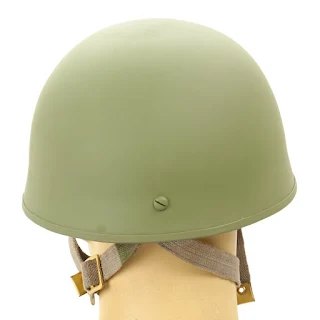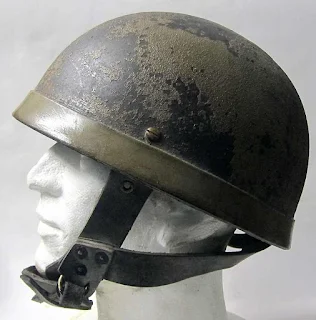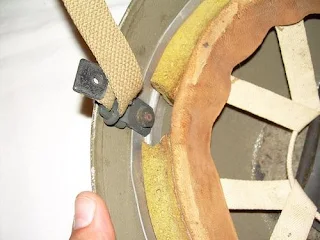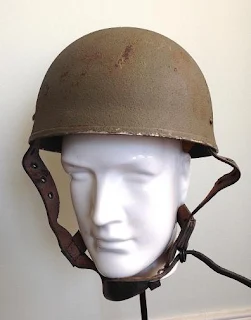In at least the past decade or
two collectors of World War II British
Airborne helmets have had the same fate befall them as did collectors of German Fallschirmjäger helmets much earlier. Reproductions of varying quality have
increasing appeared on the market. As stated elsewhere in this blog, the demand
by re-enactors has been one of the factors driving this situation. In addition
the limited supply of authentic helmets existing outside of museums, and
available to the collector’s market has greatly diminished, also breeding a
demand.
As a result individuals seeking
to acquire the genuine article are constantly searching for any and all
information on the subject, in order that they stand at least a reasonable
chance of obtaining same, in any case usually still at a substantial investment, thus doubling the importance.
Recently there has been a
significant and outstanding effort by Military Mode Publishing in
corroboration with the Airborne Assault Museum, Duxford to fill this requirement. It is the second of three
volumes published, which provide detailed historical research as well as extensive studio-quality colored photographic imagery of the
subject. Although not cheap, the book, as well as its companion volumes, has
received extensive excellent reviews and accolades from collectors. The
publishers other extremely worthy efforts include a companion book on the Denison Smock
and its successive evolution into the current issue, and a very recent publication devoted to British
Airborne Insignia from inception to date. Interested readers may find the Military Mode web site at http://www.militarymodepublishing.com. Sample pages of the book are included at their web site.
The only perspective missing in
this superlative effort is a side-by-side forensic analysis of the genuine helmets compared with examples of the reproductions that unfortunately abound. To do so is a double-edged sword, as it immediately provides a tutorial to counterfeiters as to the shortfalls in their efforts. As a result it is with somewhat mixed emotions that a direct comparison is presented herein, hopefully that it will do more good than harm. Arming both new, as well as seasoned, collectors with the information which can have a net positive effect. This article will first
present two examples of reproductions, and a third which is a probable post-WWII modification of an original helmet by the Australian Military Forces. The first being the Helmet Steel
Airborne Troops (HSAT) MK II, and the second and third being copies/modification of the HSAT MK I. Full acknowledgement and gratitude being given to International Military Antiques and WAR HATS.com. for the photographs. The first example is reasonably self-evident as a reproduction. While all three are currently sold as reproductions, the extent of antiquing implemented on
the second example could, in the author’s opinion, be very easily used to deceive in the future, although not
directly stated or inferred by the seller. After viewing the photographs below I'll let the reader be the judge. While not specifically formatted the reader can enlarge and copy the photographs as jpgs for offline comparison, or comparison with imagery of other helmets. The majority of the photographs can be enlarged without any loss of resolution by double clicking.
Photographs of Helmet Steel Airborne Troops (HSAT) MK II available from International Military Antiques. Please take note of the following features:
• Color of helmet shell.
• Color and weave of the web chin harness.
• Bright brass tips, buckles and attachment fittings for web chin harness.
• Color of interior leather headband.
• Square shape and location of interior head protector cushion.
• Material, color and configuration of interior padding.
Photographs of Helmet Steel Airborne Troops (HSAT) MK II available from International Military Antiques. Please take note of the following features:
• Color of helmet shell.
• Color and weave of the web chin harness.
• Bright brass tips, buckles and attachment fittings for web chin harness.
• Color of interior leather headband.
• Square shape and location of interior head protector cushion.
• Material, color and configuration of interior padding.
Helmet Steel
Airborne Troops (HSAT) MK I offered by WAR HATS.com. Genuine
original HSAT
MK I helmets with the fiber rim are exceedingly rare. Please carefully note the
detailed features of this reproduction helmet:
• Partially obscured manufacturer's initials and date stamps.
• Dyed interior of leather chin harness and surface texture of leather.
• Dyed chamois chin pad.
• Color and surface composition of fiber helmet rim.
This example is suspected of being a Post-WWII Australian Military Forces conversion of a HSAT MK I, replacing the original leather chin harness with the later web configuration. This would account for the empty hole seen in the rear of the helmet.
The next two examples being
shown for direct comparison are from the author’s personal collection, and are
the HSAT MK I (Leather chin harness) dated 1945, and a post WWII example HSAT
MK II dated 1955. Although purchased at Crown Surplus in Calgary, Alberta in
1970, the first helmet while using all original components, has had the exterior re-painted. Also note khaki versus white web interior crown loops, possibly a different manufacturer (BS vs BMB)? The second helmet being of later manufacture appears to be all original and
unissued, and was obtained in 1975.
The specific details of any airborne helmet that should be carefully checked for authenticity include, but are not limited to:
• The helmets manufactured during World
War II used a non-magnetic
manganese steel basic shell. Test with
magnet.
• The paint color on the wartime helmets was a browner shade
of olive
drab, not the greener shade found on
post-war and the majority of
reproduction helmets.
• The color, weave and texture of the web chin harness on
genuine
helmets differs from most
reproductions.
• The interior top thin protector pad was circular, of a black
rubberized
material, with either a smooth or a
unique rippled pattern surface.
• The original black leather chinstrap
assemblies had the edges dyed
black, with only the inner surface left
natural.
• The leather helmet liners when newly
issued were a light pink-tan
color, typical of new russet leather.
• The metal fittings on original web
chin harnesses had a black anodized
finish,
not bright brass or other bare metal.
• Known manufacturers codes stamped
into the interior side of the leather
cushioned headband include:
BMB – Most common, and standing for
Briggs Motor Bodies Ltd of Dagenham
G&S – Gimson & Slater of Nottingham
C.C.L. – Christy & Co Ltd London
BS – William Beardmore Steel Co. of Glasgow
• Be extremely cautious of any interior
markings which have the date
stamp
obliterated.
• Carefully compare the material and
configuration of the helmet’s
padding with either a known genuine
helmet, or a good color photograph
of same.
• Most surviving genuine helmets that
are in unissued/excellent condition
tend to be of either a very small size
(6 5/8) or exceptionally large (7 1/2 - 8).
• Color and surface composition of fiber or rubberized material of helmet rim
on HSAT MK I.
• Does the helmet pass the smell test; any old helmet, issued or unissued will
have a certain musty odor from age and storage, whereas a reproduction will in
all probability have the smell of new leather and/or new paint.
• Color and surface composition of fiber or rubberized material of helmet rim
on HSAT MK I.
• Does the helmet pass the smell test; any old helmet, issued or unissued will
have a certain musty odor from age and storage, whereas a reproduction will in
all probability have the smell of new leather and/or new paint.
This final example is a genuine late issue HSAT MK I (no fiber rim), and judging
from appearances probably unissued. That conclusion being reinforced by its small size
(6 5/8). With full acknowledgement and gratitude to Bosleys Buywyze website. Its
features could serve as a sealed pattern against which other helmets can be
evaluated. The importance of such a detailed inspection might be strongly indicated by
the fact that the current asking price for this specific helmet is 1450.00 GBP ($2219.63
USD).
from appearances probably unissued. That conclusion being reinforced by its small size
(6 5/8). With full acknowledgement and gratitude to Bosleys Buywyze website. Its
features could serve as a sealed pattern against which other helmets can be
evaluated. The importance of such a detailed inspection might be strongly indicated by
the fact that the current asking price for this specific helmet is 1450.00 GBP ($2219.63
USD).
An additional very subtle "purist" authenticity check for the original issue HSAT MK II, is that the web chin harness contains a secondary set of web reinforcing strips sewn around the joints in the harness. This is best described in the following series of photographs.
For those who might be interested the following are a series of photographs of the
second model of training helmet issued to British paratroops, referred to as the Bungee
helmet. The helmet incorporated a ring of sorbo rubber surrounding the head, but without
second model of training helmet issued to British paratroops, referred to as the Bungee
helmet. The helmet incorporated a ring of sorbo rubber surrounding the head, but without
any protection on top.
Most common configuration had a pair of large grommets to
facilitate hearing on each side flap. Models with four grommets on each side were also
produced. Unfortunately it suffices to say that this helmet, facilitated by it relative design
simplicity, has also been reproduced.
facilitate hearing on each side flap. Models with four grommets on each side were also
produced. Unfortunately it suffices to say that this helmet, facilitated by it relative design
simplicity, has also been reproduced.

















































29 comments:
Dear sirs, I have a Mk.III helmet and I bought it as an original one. Reading your excellent article (congrats for that!!!) I think I really have an original helmet but I am not an expert on British helmets.
Please, would it be possible for you take a look at the pics I have and help me on determining whether my helmet is WWII period or not?
Any help would be greatly appreciated.
Thanks in advance and best regards,
Alex Triffoni.
Hello Alex,
Apologies, short of putting my personal e-mail address out to the entire world, it seems impractical. A suggestion please. Given the 13 inspection steps listed in this article to establish authenticity; count how many your helmet passes. Use the photos in the article for comparison. That should give you a percentage (confidence) number. If that number is say 11 out of 13 (85%), that's the certainty you have the real thing. Being non-magnetic is important. Hope this is of some assistance.
Arnhem Jim
Hi Jim,
Thanks for such an informative and well researched website. I have a non magnetic helmet no chinstrap only single webbing strap and hole at back. I have followed your advice but can't seem to find a mention of just single webbing strap anywhere. Do you have any knowledge of this?
Hello Oscar Charlie,
Although I'm not positive without either physically seeing the helmet. or images of it, I believe that the helmet you have is probably the WWII Royal Armoured Corps (RAC) steel configuration. While the basic helmet shell is common to both the paratroop and dispatch rider helmet, the suspension is different in each. You may want to check the following web site to see if it contains your helmet; http://combathelmets.blogspot.com/2008/08/royal-armoured-corps-mkiii.html. Hope this has been of some assistance, and thank you very mach for your interest in this blog.
Arnhem Jim
Dear Jim-are you still replying to queries please? Thanks,David.
Hello David,
Yes, I most certainly am, to the extent of my knowledge and reference library will allow me. Thank you very much for your interest.
Regards,
Arnhem Jim
Hi Jim
I just tried to send you an email using your one on your profile page it came back to me.
It regards a helmet with photos i tried sending.
Regards
Nick
Hello Nick,
Apologies been away for holidays. Is your question regarding one of the helmets shown in my blog article? If not, recommend you submit your photos to the British & Commonwealth Badge Forum (https://www.britishbadgeforum.com/forums/), it is a very easy way for me to receive images, and respond to your query. If you have not joined It is also an excellent source of information.
Best regards,
Arnhem JIm
im trying to find the correct colour for a british despatch rider helmet liner bmb 1945
Hello Unknown,
In regard to your query; the interior headband is the same light tan coloured leather as the para helmet. The interior of the earflaps is a cream coloured swede leather. The exterior of the flaps is the same brown coloured leather used in all leather RAF/FAA helmets of the same vintage. If you look at the photos in the following blog article you can see the exact helmet in one of the images; http://arnhemjim.blogspot.com/2011/06/small-collection-of-military-headdress.html. Hope that is of assistance. Christmas Greetings!
Best regards,
Arnhem Jim
Are there different sizes shells for para helmets. Thankyou
Hello Unknown,
Early helmets were produced in one shell size only. However with the introduction of the HSAT two shell sizes were introduced, Large and Normal. At the same time lining sizes were increased to a range of sixteen different increments.
Best regards and stay safe,
Arnhem Jim
Hello again Unknown,
Am not able to edit my comments, so this additional comment; There were seventeen, not sixteen lining sizes of HSAT helmets.
Arnhem Jim
Excellent article, was a tremendous help. Thanks for sharing your knowledge.
Hi Jim,
First, let me thank you for a very helpful website! I have what I believe to be an authentic HSAT MK II helmet that passes all of your tests except a couple. First, I cannot find a maker's stamp, although I do see what appears to be an "E" about 3/4" high and very faintly stamped on the inside surface of the leather headband. There is writing in black ink on the inside of the headband; "SGT GOOD J," "CPL DUNSMORE WA," "SN1109," and "OVERALL." Second, the exterior of the shell is painted gloss black, while the interior is a very dark olive drab. Any help you could provide in identifying this item would be greatly appreciated!
Thanks,
Dave
Looking at the inside of the headband under higher magnification, I found (under some of the handwritten text) a stamped horizontal line about an inch long, above which is something that looks like "II" and below which is "1953." Obviously this helmet doesn't date from WW2. I also found, close to the above, the size, which is "7 1/8." So, do you know which country and branch of service would have painted these helmets black in the 1950's? Thanks!
After further FURTHER review, I believe the "E" is actually the most visible part of a stamped "B," the first B of BMB. And, I can convince myself that I can see the top half of the second B as well. So, this is a postwar British helmet much like this one:
https://www.worthpoint.com/worthopedia/british-army-post-ww2-paratrooper-1839681559
But why is the outer shell painted gloss black?
Hello Dave,
Unfortunately I have no plausible reason for the black paint. There are some reproduction helmets that appear to have a matte black finish but nothing in gloss. I just don't know. Sorry I can't be of more assistance.
Stay safe,
Arnhem JIm
Thanks, Jim!
Hi again Jim,
Would this helmet lose value (assuming it has much) if I were to strip the gloss black paint and repaint it in WW2 color?
Thanks!
Dave
Hello Dave,
I'm no expert, but with the rest of the helmet being correct, and the prices of the helmets significantly increasing I think that you would do nothing but enhance the value. Depending upon the base of the black paint you might want to work with various paint thinners, working up to acetone as a last choice due to its highly corrosive nature. Recommend using turpentine then mineral spirits first. Who knows, you may be able to get down to the original paint without destroying it. Think it would be well worth the time and effort of an Internet research project to determine the best way to proceed in stripping the black paint. In the event you have to repaint the exterior, am certain there are sources for spray cans available of the exact colour as the original. Hope this has been of some assistance and best of luck.
Regards,
Arnhem Jim
Great Web site Jim,
I have seen a WW2 British airborne helmet stamped "CPL 1942" on the rubber pad in the crown. Do you have any info on such a marking?
Thanks.
Hello Anonymous,
Based upon my records of UK military contractors in WWII, the letters could possibly be the initials of Celnik & Power Ltd., Stannard Road, W6, London, however their official contractor code was S324. It may be something as mundane as the initials for Corporal, but not very likely. Personally have never seen any letters on the black rubber interior crown pads. That's about the most assistance I can provide. Thank you very much for your interest in the blog.
Best regards,
Arnhem Jim
Hello randyorton,
Sincere thanks for your kind remarks on the blog post, I'm glad that you found the information of some assistance.
Best regards,
Jim
Graceful written content on this blog is really useful for everyone same as I got to know. Difficult to locate relevant and useful informative blog as I found this one to get more knowledge but this is really a nice one. Deutschland Erwache flag
Some airborne helmets have a rough texture finish to them. Do we know what this texture is made from...sand...grit???
Anonymous,
My best understanding is that before the last coat of paint, while still tacky, a fine layer of high quality sand is blown over the entire still damp outer surface. Then the final coat of paint was sprayed over that same surface, and allowed to dry, given the textured effect. Thank you for your interest and participating in the blog.
Regards,
Arnhem Jim
Hi Jim, just a simple question. Did all ww2 paratrooper helmets have makers mark and year of manufacture on them ? I have one being offered to me without any markings by he says there may be some underneath the liner but doesn’t want to remove it, kind regards,Ray
I bought a British helmet, but i'm not sure what type it is. Is it possible to send you several pictures of it? r.velde@hetnet.nl
Post a Comment